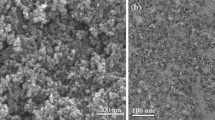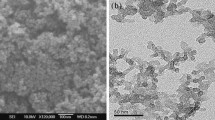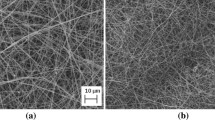Abstract
In this study, carbon aerogels (CA) are prepared through the pyrolysis of resorcinol-formaldehyde (RF) aerogel, and are then used as reinforcement in epoxy resin (ER). The effect of the pyrolysis time of resorcinol-formaldehyde aerogel on the properties of the final composites is also investigated. In order to improve the diffusion of epoxy resin into the pores of the carbon aerogels, a reactive diluent is used. Two types of carbon aerogels are prepared by the pyrolysis of resorcinol-formaldehyde aerogel for 1 h. and 3 h. The morphological and electrical properties of carbon aerogels are compared, and the mechanical strength, thermal stability, and electrical conductivity of the ER/CA nanocomposites are examined. It is observed that in the presence of carbon aerogels, the investigated properties are enhanced. In addition, the properties of the nanocomposites are improved further when they are reinforced by the carbon aerogels pyrolyzed for 3 h due to the more physical interaction attributed to the higher surface area of this type of carbon aerogels.





Similar content being viewed by others
References
Wang X, Jin J, Song M (2013) An investigation of the mechanism of graphene toughening epoxy. Carbon 65:324–333
Liu D, Zhao W, Liu S, Cen Q, Xue Q (2016) Comparative tribological and corrosion resistance properties of epoxy composite coatings reinforced with functionalized fullerene C60 and graphene. Surf Coat Technol 286:354–364
Pourhashem S, Vaezi MR, Rashidi A, Bagherzadeh MR (2016) Exploring corrosion protection properties of solvent based epoxy-graphene oxide nanocomposite coatings on mild steel. Eval Program Plann
Shokrieh MM, Shokrieh Z, Hashemianzadeh SM (2014) A novel combined molecular dynamics – micromechanics method for modeling of stiffness of graphene / epoxy nanocomposites with randomly distributed graphene. 64:96–101
Naem A, Alamry S, Prusty BG et al (2014) Improved crack resistance and fracture toughness using MWCNT modified epoxy for delaminated composite structures. Procedia Mater Sci 3:805–810
Prolongo SG, Moriche R, Sánchez M, Ureña A (2014) Advantages and disadvantages of the addition of graphene nanoplatelets to epoxy resins. Eur Polym J 61:206–214
Liu S, Yan H, Fang Z, Wang H (2014) Effect of graphene nanosheets on morphology , thermal stability and flame retardancy of epoxy resin. Compos Sci Technol 90:40–47
Carolan D, Kinloch AJ, Ivankovic A et al (2016) Toughening of epoxy-based hybrid nanocomposites. Polymer 97:179–190
Meng Q, Araby S, Ma J (2015) Toughening mechanisms in epoxy/graphene platelets composites. In: Woodhead publishing series in composites science and engineering. Elsevier, pp 73–112
Becker O, Varley R, Simon G (2002) Morphology , thermal relaxations and mechanical properties of layered silicate nanocomposites based upon high-functionality epoxy resins. Polymer 43:4365–4373
Liu S, Gu L, Zhao H, Chen J, Yu H (2016) Corrosion resistance of graphene-reinforced waterborne epoxy coatings. J Mater Sci Technol 32:425–431
Monetta T, Acquesta A, Bellucci F (2015) Graphene/Epoxy Coating as Multifunctional Material for Aircraft Structures. 423–434
Zhang Z, Zhang W, Li D, Sun Y, Wang Z, Hou C, Chen L, Cao Y, Liu Y (2015) Mechanical and anticorrosive properties of graphene/epoxy resin composites coating prepared by in-situ method. Int J Mol Sci 16:2239–2251
Gojny FH, Wichmann MHG, Köpke U, Fiedler B, Schulte K (2004) Carbon nanotube-reinforced epoxy-composites: enhanced stiffness and fracture toughness at low nanotube content. Compos Sci Technol 64:2363–2371
Naderi M, Hoseinabadi M, Najafi M, Motahari S, Shokri M (2018) Investigation of the mechanical, thermal, and anticorrosion properties of epoxy nanocomposite coatings: effect of synthetic hardener and nanoporous graphene. J Appl Polym Sci 135:46201. https://doi.org/10.1002/app.46201
Hoseinabadi M, Naderi M, Najafi M, Motahari S (2017) A study of rigid polyurethane foams : The effect of synthesized polyols and nanoporous graphene. 45001:1–6. https://doi.org/10.1002/app.45001
Cha J, Hoon G, Kyoo J, et al (2017) Improvement of modulus , strength and fracture toughness of CNT / Epoxy nanocomposites through the functionalization of carbon nanotubes. 129:169–179
Kim JA, Seong DG, Kang TJ, Youn JR (2006) Effects of surface modification on rheological and mechanical properties of CNT / epoxy composites. 44:1898–1905
Tang B, Hu G, Gao H, Hai L (2015) International Journal of Heat and Mass Transfer Application of graphene as filler to improve thermal transport property of epoxy resin for thermal interface materials. 85:420–429
Hsieh TH, Huang YS, Shen MY (2015) Mechanical properties and toughness of carbon aerogel/epoxy polymer composites. J Mater Sci 50:3258–3266
Aghabararpour M, Mohsenpour M, Motahari S, Abolghasemi A (2018) Mechanical properties of isocyanate crosslinked resorcinol formaldehyde aerogels. J Non-Cryst Solids 481:548–555
Tan C, Fung BM, Newman JK, Vu C (2001) Organic aerogels with very high impact strength. Adv Mater 13:644–646
Hrubesh LW (1998) Aerogel applications. J Non-Cryst Solids 225:335–342
Al-muhtaseb BSA, Ritter JA (2003) Preparation and properties of resorcinol-formaldehyde organic and carbon gels. Adv Mater 15:101–114
Gupta N, Ricci W (2008) Processing and compressive properties of aerogel/epoxy composites. J Mater Process Technol 198:178–182
Rezazadeh V, Pourhossaini MR, Salimi A (2017) Effect of amine-functionalized dispersant on cure and electrical properties of carbon nanotube/epoxy nanocomposites. Prog Org Coat 111:389–394
Zhang G, Xie Q, Ma C, Zhang G (2018) Progress in organic coatings permeable epoxy coating with reactive solvent for anticorrosion of concrete. Prog Org Coat 117:29–34
Zhang SQ, Wang J, Shen J, et al (1999) THE Investigation of the Adsorption Character of Carbon Aerpgels. 11:375–381
Wiener M, Reichenauer G, Hemberger F, Ebert H Thermal conductivity of monolithic synthetic hard carbons as a function of pyrolysis temperature
Richardson MOW, Wisheart MJ (1996) Reviwe of low-velocity impact properties of composite materials. Compos Part A 27:1123–1131
Hajian M, Reisi MR, Koohmareh GA, Zanjani Jam AR (2012) Preparation and characterization of Polyvinylbutyral/graphene nanocomposite. J Polym Res 19:9966
Meng Q, Wu H, Zhao Z, Araby S, Lu S, Ma J (2017) Free-standing, flexible, electrically conductive epoxy/graphene composite films. Compos A Appl Sci Manuf 92:42–50
Li H, Wu S, Wu J, Huang G (2014) Enhanced electrical conductivity and mechanical property of SBS/graphene nanocomposite. J Polym Res 21:456
Sivanjineyulu V, Chang YH, Chiu FC (2017) Characterization of carbon nanotube- and organoclay-filled polypropylene/poly(butylene succinate) blend-based nanocomposites with enhanced rigidity and electrical conductivity. J Polym Res 24:130
Author information
Authors and Affiliations
Corresponding authors
Additional information
Publisher’s note
Springer Nature remains neutral with regard to jurisdictional claims in published maps and institutional affiliations.
Rights and permissions
About this article
Cite this article
Aghabararpour, M., Naderi, M., Motahari, S. et al. A study on resorcinol formaldehyde carbon aerogel/epoxy nanocomposites: the effect of carbon aerogel pyrolysis time. J Polym Res 26, 59 (2019). https://doi.org/10.1007/s10965-019-1721-9
Received:
Accepted:
Published:
DOI: https://doi.org/10.1007/s10965-019-1721-9




